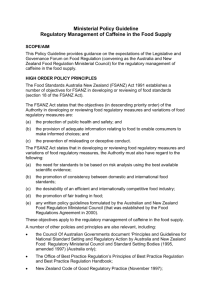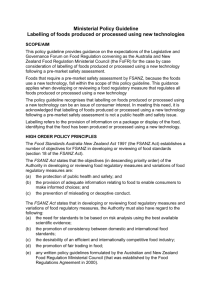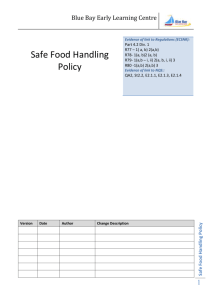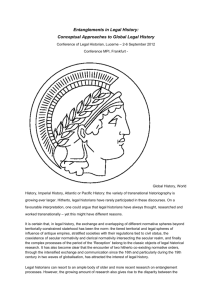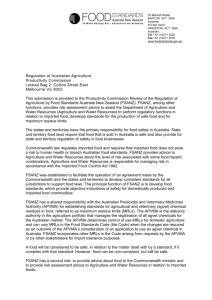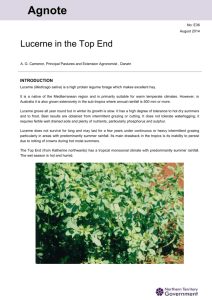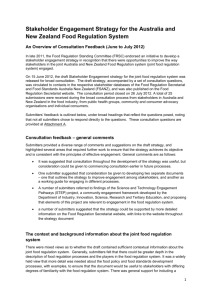Application A1085 Food derived from Reduced Lignin Lucerne Line
advertisement
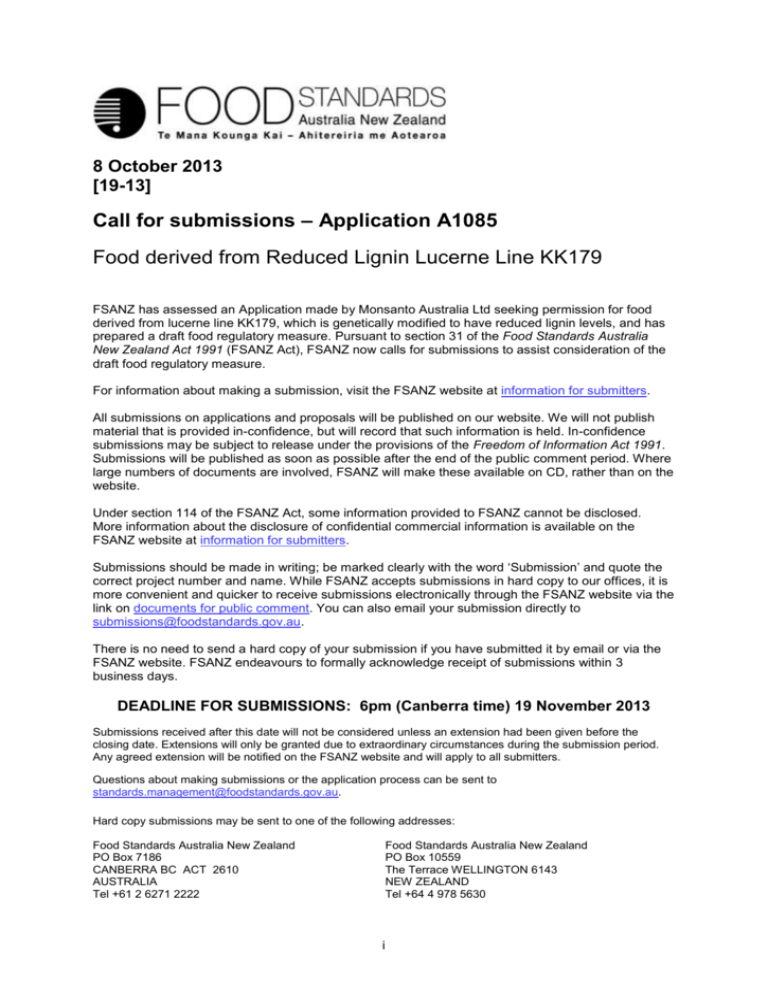
8 October 2013 [19-13] Call for submissions – Application A1085 Food derived from Reduced Lignin Lucerne Line KK179 FSANZ has assessed an Application made by Monsanto Australia Ltd seeking permission for food derived from lucerne line KK179, which is genetically modified to have reduced lignin levels, and has prepared a draft food regulatory measure. Pursuant to section 31 of the Food Standards Australia New Zealand Act 1991 (FSANZ Act), FSANZ now calls for submissions to assist consideration of the draft food regulatory measure. For information about making a submission, visit the FSANZ website at information for submitters. All submissions on applications and proposals will be published on our website. We will not publish material that is provided in-confidence, but will record that such information is held. In-confidence submissions may be subject to release under the provisions of the Freedom of Information Act 1991. Submissions will be published as soon as possible after the end of the public comment period. Where large numbers of documents are involved, FSANZ will make these available on CD, rather than on the website. Under section 114 of the FSANZ Act, some information provided to FSANZ cannot be disclosed. More information about the disclosure of confidential commercial information is available on the FSANZ website at information for submitters. Submissions should be made in writing; be marked clearly with the word ‘Submission’ and quote the correct project number and name. While FSANZ accepts submissions in hard copy to our offices, it is more convenient and quicker to receive submissions electronically through the FSANZ website via the link on documents for public comment. You can also email your submission directly to submissions@foodstandards.gov.au. There is no need to send a hard copy of your submission if you have submitted it by email or via the FSANZ website. FSANZ endeavours to formally acknowledge receipt of submissions within 3 business days. DEADLINE FOR SUBMISSIONS: 6pm (Canberra time) 19 November 2013 Submissions received after this date will not be considered unless an extension had been given before the closing date. Extensions will only be granted due to extraordinary circumstances during the submission period. Any agreed extension will be notified on the FSANZ website and will apply to all submitters. Questions about making submissions or the application process can be sent to standards.management@foodstandards.gov.au. Hard copy submissions may be sent to one of the following addresses: Food Standards Australia New Zealand PO Box 7186 CANBERRA BC ACT 2610 AUSTRALIA Tel +61 2 6271 2222 Food Standards Australia New Zealand PO Box 10559 The Terrace WELLINGTON 6143 NEW ZEALAND Tel +64 4 978 5630 i Table of Contents 1. EXECUTIVE SUMMARY ..................................................................................................................... 2 2. INTRODUCTION .................................................................................................................................. 3 2.1 2.2 2.3 2.4 2.5 THE APPLICANTS ...................................................................................................................................3 THE APPLICATION..................................................................................................................................3 THE CURRENT STANDARD .....................................................................................................................3 REASONS FOR ACCEPTING THE APPLICATION ......................................................................................3 PROCEDURE FOR ASSESSMENT ............................................................................................................3 SUMMARY OF THE ASSESSMENT .................................................................................................. 4 3. 3.1 RISK ASSESSMENT ................................................................................................................................4 3.2 RISK MANAGEMENT ...............................................................................................................................4 3.2.1 Cost/benefit analysis ......................................................................................................................4 3.2.2 Other measures ..............................................................................................................................6 3.2.3 Relevant New Zealand standards ................................................................................................6 3.2.4 Any other relevant matters ............................................................................................................6 3.2.5. Addressing FSANZ’s objectives for standards-setting .........................................................7 3.3. RISK COMMUNICATION...........................................................................................................................9 3.3.3 World Trade Organization (WTO) ................................................................................................9 DRAFT VARIATION ............................................................................................................................. 9 4. 4.1.1 Implementation .............................................................................................................................10 REFERENCES ................................................................................................................................... 10 5. ATTACHMENT A – DRAFT VARIATION TO THE AUSTRALIA NEW ZEALAND FOOD STANDARDS CODE ............11 ATTACHMENT B – DRAFT EXPLANATORY STATEMENT....................................................................................13 Supporting documents The following document, which informed the assessment of this Application, is available on the FSANZ website at http://www.foodstandards.gov.au/code/applications/Pages/A1085.aspx SD1 Safety Assessment Report: Application A1085 – Food derived from Reduced lignin Lucerne Line KK179 1 1. Executive summary Food Standards Australia New Zealand (FSANZ) received an Application from Monsanto Australia Pty Ltd on 10 April 2013. The Applicants requested a variation to Standard 1.5.2 – Food produced using Gene Technology, in the Australia New Zealand Food Standards Code (the Code), to permit the sale and use of food derived from genetically modified (GM) lucerne line KK179 that has reduced lignin levels. This Application is being assessed under the General Procedure. The primary objective of FSANZ in developing or varying a food regulatory measure, as stated in section 18 of the FSANZ Act, is the protection of public health and safety. Accordingly, the safety assessment is a central part of considering an application. The safety assessment of lucerne line KK179 is provided in Supporting Document 1. No potential public health and safety concerns have been identified. Based on the data provided in the present Application, and other available information, food derived from lucerne line KK179 is considered to be as safe for human consumption as food derived from conventional lucerne cultivars. FSANZ has prepared a draft variation to Standard 1.5.2 to include food derived from lucerne line KK179. 2 2. Introduction 2.1 The Applicants Monsanto Australia Ltd is a technology provider to the agricultural and food industries. 2.2 The Application Application A1085 was submitted by Monsanto Australia Ltd on 10 April 2013. It sought approval for food derived from lucerne line KK179 under Standard 1.5.2 – Food produced using Gene Technology. Lucerne line KK179 has reduced lignin content. Lignin is a non-carbohydrate phenolic polymer deposited in plant cell walls, particularly in the vascular tissue, and is a contributor to the quality of forage eaten by grazing animals. The reduced level of lignin in lucerne KK179 has been achieved using RNA interference (RNAi) to suppress the expression of one of the genes involved in lignin biosynthesis. The Applicant claims this modification will provide growers with greater flexibility at harvest time, enabling the crop to be harvested at a later stage without appreciable loss of forage quality. It is not intended that KK179 enter the food supply. However, a food approval is sought in case this inadvertently occurs. 2.3 The current Standard Pre-market approval is necessary before food derived from any genetically modified (GM) line may enter the Australian and New Zealand food supply. Approval of GM foods under Standard 1.5.2 is contingent on completion of a comprehensive pre-market safety assessment. Foods that have been assessed and approved are listed in the Schedule to the Standard. Standard 1.5.2 contains specific labelling provisions for approved GM foods. GM foods and ingredients (including food additives and processing aids from GM sources) must be identified on labels with the words ‘genetically modified’, if novel DNA and/or novel protein from an approved GM variety is present in the final food, or the food has altered characteristics. In the latter case the Standard also allows for additional labelling about the nature of the altered characteristics. 2.4 Reasons for accepting the Application The Application was accepted for assessment because: 2.5 it complied with the procedural requirements under subsection 22(2) it related to a matter that warranted the variation of a food regulatory measure. it was not so similar to a previous application for the variation of a food regulatory measure that it ought to be rejected there was no other relevant matter to consider. Procedure for assessment The Application is being assessed under the General Procedure. 3 3. Summary of the assessment 3.1 Risk assessment The safety assessment of lucerne line KK179 is provided in the supporting document (SD1) and included the following key elements: a characterisation of the transferred genetic material, its origin, function and stability in the lucerne genome the changes at the level of DNA and RNA in the whole food detailed compositional analyses evaluation of intended and unintended changes. The assessment of lucerne line KK179 was restricted to food safety and nutritional issues. Any risks related to the release into the environment of GM plants used in food production, or the safety of animal feed or animals consuming feed derived from GM plants have not been addressed in this assessment. No potential public health and safety concerns have been identified. On the basis of the data provided in the present Application, and other available information, food derived from lucerne line KK179 is considered to be as safe for human consumption as food derived from conventional lucerne cultivars. 3.2 Risk management When assessing this Application and the subsequent development of a food regulatory measure, FSANZ has had regard to the following matters in section 29 of the FSANZ Act: whether costs that would arise from a food regulatory measure developed or varied as a result of the application outweigh the direct and indirect benefits to the community, Government or industry that would arise from the development or variation of the food regulatory measure whether other measures (whether available to FSANZ or not) would be more costeffective than a food regulatory measure developed or varied as a result of the Application any relevant New Zealand standards any other relevant matters. Two regulatory options were considered: (1) prepare a draft variation to Standard 1.5.2 to include food derived from lucerne line KK179; or (2) reject the Application. FSANZ has decided to prepare a draft variation to Standard 1.5.2 because the potential benefits of approving the variation outweigh the potential costs, and because no public health or safety concerns resulting from consumption of food derived from lucerne line KK179 have been raised. 3.2.1 Cost/benefit analysis A consideration of the cost/benefit of the regulatory options is not intended to be an exhaustive, quantitative financial analysis of the options as most of the impacts that are considered cannot be assigned a dollar value. Rather, the analysis seeks to highlight the qualitative impacts of criteria that are relevant to each option. These criteria are deliberately limited to those involving broad areas such as trade, consumer information and compliance. 4 The Office of Best Practice Regulation (OBPR), in a letter to FSANZ dated 24 November 2010 (reference 12065), provided an exemption from the need for the OBPR to be informed about GM food applications. It should be noted it is not intended that lucerne line KK179 be for human consumption as its purpose is for use in animal feed, primarily in northern America. The Applicant has stated that the Monsanto/Forage Genetics International (FGI) Technology Use Agreement with growers for this product would strictly prohibit the commercial sale of KK179 alfalfa seed for food uses. Further, the production of KK179 alfalfa seed would only be permitted through strict licensing agreements between growers and Monsanto/FGI, which require that all seed be returned to Monsanto/FGI. The following options are therefore relevant in the event of inadvertent entry of food from line KK179 into the Australian/New Zealand food supply. As fresh sprouts are not imported, the most likely route of inadvertent entry would be via comingled seed for sowing or sprouting. In this case, since the seed would be a living genetically modified organism (GMO) it would, in the first instance, be subject to the regulations governing the release of a GMO into the environment and would therefore come under the jurisdiction of the Office of the Gene Technology Regulator in Australia and the Environmental Protection Authority in New Zealand. Relevant information on the importation of lucerne seed is available on the NZ Ministry for Primary Industries website (http://www.biosecurity.govt.nz/related/related_faqs/ihs/search?page=2&expand=2475) 3.2.1.1 Option 1 – Develop a draft variation to Standard 1.5.2 Consumers: Broader availability of imported lucerne products as there would be no restriction on imported foods containing lucerne line KK179, providing those products did not breach regulatory requirements concerning environmental release. Potentially, no increase in the prices of imported foods manufactured using comingled lucerne products. The safety assessment found that there would be no impact on public health and safety if KK179 were introduced into the food supply. Government: Benefit that if lucerne line KK179 was detected in lucerne imports, approval would ensure compliance of those products with the Code. This would ensure no potential for trade disruption on regulatory grounds. Approval of lucerne line KK179 would ensure no conflict with WTO responsibilities. Industry: Importers of processed foods containing lucerne derivatives would benefit as foods derived from lucerne line KK179 would be compliant with the Code, allowing broader market access and increased choice in raw materials. Retailers may be able to offer a broader range of lucerne products or imported foods manufactured using lucerne derivatives. 3.2.1.2 Option 2 – Reject application Consumers: Possible restriction in the availability of imported lucerne products to those products that do not contain lucerne line KK179. 5 No effect on consumers wishing to avoid GM foods, as food from lucerne line KK179 is not currently permitted in the food supply. Potential increase in price of imported lucerne foods due to requirement for segregation of lucerne line KK179. Government: Potential effect if considered inconsistent with WTO obligations but this would be in terms of trade policy rather than in government revenue. Industry: Possible restriction on imports of lucerne products if lucerne line KK179 were to be commercialised overseas. Potential longer-term effect - any successful WTO challenge has the potential to impact adversely on food industry. As food from lucerne line KK179 has been found to be as safe as food from conventional cultivars of lucerne, not preparing a draft variation would offer little benefit to consumers, as approval of lucerne line KK179 by other countries could limit the availability of imported lucerne products in the Australian and New Zealand markets. In addition, this option would result in the requirement for segregation of any products containing lucerne line KK179 from those containing approved lucerne lines which would be likely to increase the costs of imported lucerne-derived products. Based on the conclusions of the safety assessments, the potential benefits of approving the variation outweighed the potential costs. 3.2.2 Other measures There were no measures that could achieve the same result other than an amendment to Standard 1.5.2. 3.2.3 Relevant New Zealand standards Standard 1.5.2 applies in New Zealand. 3.2.4 Any other relevant matters The Applicant has submitted a food and feed safety and nutritional assessment summary for KK179 to the United States Food and Drug Administration and has also requested a Determination of Nonregulated Status for KK179, including all progenies derived from crosses between KK179 and other lucerne, from the Animal and Plant Health Inspection Service of the U.S. Department of Agriculture. The Applicants have submitted applications for regulatory approval of KK179 to a number of other countries, as listed in Table 1. To date, none has been finalised. Table 1: List of countries to whom applications for food/feed approval of lucerne line KK179 have been submitted Country Canada Type of approval sought feed Agency Food Inspection Agency food Health Canada 6 Country Agency Ministry of Health, Labor, and Welfare Japan Ministry of Agriculture, Forestry and Fisheries Ministry of Food and Drug Safety (Formerly Korea Food and Drug Administration) Rural Development Administration Korea Singapore Type of approval sought food feed food feed food/feed Agri‐Food and Veterinary Authority Regulatory submissions will be made to countries that import significant lucerne or food and feed products derived from countries where KK179 lucerne will be grown, including, but not limited to Ministry of Agriculture, People’s Republic of China. The Applicant has advised that lucerne line KK179 will be commercially cultivated predominantly in North America and there is no intention to grow the plant line in Australia or New Zealand. Such cultivation in Australia or New Zealand could have an impact on the environment, which would need to be independently assessed by the Office of the Gene Technology Regulator in Australia and the Environmental Protection Authority in New Zealand, before commercial release in either country could be permitted. 3.2.5 Addressing FSANZ’s objectives for standards-setting FSANZ has also considered the three objectives in subsection 18(1) of the FSANZ Act during the assessment. 3.2.5.1 Protection of public health and safety Food derived from lucerne line KK179 has been assessed according to the safety assessment guidelines prepared by FSANZ (2007). No public health and safety concerns were identified in this assessment. Based on the available evidence, including detailed studies provided by the Applicant, food derived from lucerne line KK179 is considered as safe and wholesome as food derived from other commercial lucerne cultivars. 3.2.5.2 The provision of adequate information relating to food to enable consumers to make informed choices In Section 2.2, FSANZ notes it is not intended that KK179 enter the food supply. However, should it enter, food derived from reduced lignin lucerne line KK179 would be required to be labelled as genetically modified if novel DNA or novel protein is present in the final food. Because the genetic modification involves RNAi using sequences from an endogenous gene it is unlikely that there will be either novel DNA or protein present in any KK179 food products. Standard 1.5.2 also contains provision for additional labelling requirements in cases where the genetic modification has resulted in one or more significant composition or nutritional parameters having values outside the normal range of values for existing counterpart food not produced using gene technology. In developing the GM food labelling standard, it was recognised there may be instances where additional labelling would be appropriate, for example where a property or characteristic of the food means that it is no longer equivalent to an existing counterpart food (Proposal P97). 7 Lucerne line KK179 has a reduced level of lignin compared with a non-GM comparator. While this reduction in lignin content changes the agronomic characteristics of the crop, the lignin level is within the normal range of variation found in non-GM lucerne and is therefore not considered to be of nutritional significance for humans. It is noted that the intent of the genetic modification was not to alter the nutritional profile per se but rather to alter an agronomic trait. Line KK179 is therefore not considered to have significant composition or nutritional parameters for the purposes of labelling GM foods. 3.2.5.3 The prevention of misleading or deceptive conduct Detection methodology An Expert Advisory Group (EAG), involving laboratory personnel and representatives of the Australian and New Zealand jurisdictions has been formed by the Food Regulation Standing Committee’s Implementation Sub-Committee to identify and evaluate appropriate methods of analysis associated with all applications to FSANZ, including GM applications. The EAG has indicated that for GM applications, the full DNA sequence of the insert and adjacent genomic DNA are sufficient data to be provided. Using this information, any analytical laboratory would be able to develop a PCR-based detection method. This sequence information has been supplied by the Applicant for line KK179 to satisfy the requirement for detection methodology in the FSANZ Application Handbook (FSANZ, 2011). 3.2.5.4 Subsection 18(2) considerations FSANZ has also had regard to the matters listed in subsection 18(2): The need for standards to be based on risk analysis using the best available scientific evidence. FSANZ’s approach to the safety assessment of all GM foods applies concepts and principles outlined in the Codex General Principles for the Risk Analysis of Foods derived from Biotechnology (Codex, 2004). Based on these principles, the risk analysis undertaken for lucerne line KK179 used the best scientific evidence available. The Applicants submitted to FSANZ, a comprehensive dossier of quality-assured raw experimental data. In addition to the information supplied by the Applicants, other available resource material including published scientific literature and general technical information was used in the safety assessment. The promotion of consistency between domestic and international food standards. This is not a consideration as there are no relevant international standards. The desirability of an efficient and internationally competitive food industry. The inclusion of genetically modified foods in the food supply, where there are no safety concerns, generally allows for innovation by developers and a widening of the technological base for the production of foods. Lucerne line KK179 is not intended as a food crop and therefore its consideration for approval in the food supply is a precautionary move designed to ensure compliance in the event there is inadvertent mixing. 8 The promotion of fair trading in food. The cost/benefit analysis in Section 3.2.1 lists a number of considerations that address fair trading with respect to lucerne line KK179. Any written policy guidelines formulated by the Ministerial Council. No specific policy guidelines have been developed since Standard 1.5.2 commenced. 3.3. Risk communication FSANZ developed and applied a basic communication strategy to this Application. All calls for submissions are notified via the FSANZ Notification Circular, media release and through FSANZ’s social media tools and Food Standards News. Subscribers and interested parties are also notified about the availability of reports for public comment. The process by which FSANZ considers standard matters is open, accountable, consultative and transparent. Public submissions are called to obtain the views of interested parties on issues raised by the application and the impacts of regulatory options. FSANZ also publishes all applications on the FSANZ website. The draft variation will be considered for approval by the FSANZ Board taking into account public comments received on this Call for Submissions. The Applicant and individuals and organisations that make submissions on this Application will be notified at each stage of the assessment. If the draft variation to the Code is approved by the FSANZ Board, that decision will be notified to the COAG Legislative and Governance Forum on Food Regulation1 (the Forum). If the Board’s decision is not subject to a request for a review, the Applicant and stakeholders, including the public, will be notified of the gazettal of the variation to the Code in the national press and on the website. 3.3.1 World Trade Organization (WTO) As members of the World Trade Organization (WTO), Australia and New Zealand are obliged to notify WTO member nations where proposed mandatory regulatory measures are inconsistent with any existing or imminent international standards and the proposed measure may have a significant effect on trade. There are no relevant international standards and amending the Code to permit food derived from reduced-lignin lucerne line KK179 is unlikely to have a significant effect on international trade as it would permit food derived from reduced-lignin lucerne line KK179 to be imported into Australia and New Zealand and sold, where currently sale is prohibited. Therefore, a notification to the WTO under Australia’s and New Zealand’s obligations under the WTO Technical Barriers to Trade or Sanitary and Phytosanitary Measures Agreement was not considered necessary. 4. Draft variation The draft variation to Standard 1.5.2 is at Attachment A. 1 Previously known as the Australia and New Zealand Food Regulation Ministerial Council 9 A draft Explanatory Statement is at Attachment B. 4.1.1 Implementation The variation would take effect on gazettal. 5. References Codex (2004) Principles for the risk analysis of foods derived from modern biotechnology. Report No. CAC/GL 44-2003, Codex Alimentarius Commission, Rome. http://www.codexalimentarius.net/web/standard_list.do?lang=en. FSANZ (2007) Safety assessment of genetically modified foods – Guidance document. Document prepared by Food Standards Australia New Zealand. http://www.foodstandards.gov.au/_srcfiles/GM%20FINAL%20Sept%2007L%20_2_.pdf. FSANZ (2011) Application handbook. Prepared by Food Standards Australia New Zealand. http://www.foodstandards.gov.au/foodstandards/changingthecode/applicationshandbook.cfm Attachments A. B. Draft variation to the Australia New Zealand Food Standards Code Draft Explanatory Statement 10 Attachment A – Draft variation to the Australia New Zealand Food Standards Code Food Standards (A1085 – Food derived from Reduced Lignin Lucerne Line KK179) Variation The Board of Food Standards Australia New Zealand gives notice of the making of this variation under section 92 of the Food Standards Australia New Zealand Act 1991. The Standard commences on the date specified in clause 3 of this variation. Dated [To be completed by Standards Management Officer] Standards Management Officer Delegate of the Board of Food Standards Australia New Zealand Note: This variation will be published in the Commonwealth of Australia Gazette No. FSC XX on XX Month 20XX. This means that this date is the gazettal date for the purposes of clause 3 of the variation. 11 1 Name This instrument is the Food Standards (A1085 – Food derived from Reduced Lignin Lucerne Line KK179) Variation. 2 Variation to Standards in the Australia New Zealand Food Standards Code The Schedule varies a Standard in the Australia New Zealand Food Standards Code. 3 Commencement The variation commences on the date of gazettal. SCHEDULE [1] Standard 1.5.2 is varied by inserting in numerical order in the Schedule “ 4.2 Food derived from reduced lignin lucerne line KK179 ” 12 Attachment B – Draft Explanatory Statement 1. Authority Section 13 of the Food Standards Australia New Zealand Act 1991 (the FSANZ Act) provides that the functions of Food Standards Australia New Zealand (the Authority) include the development of standards and variations of standards for inclusion in the Australia New Zealand Food Standards Code (the Code). Division 1 of Part 3 of the FSANZ Act specifies that the Authority may accept applications for the development or variation of food regulatory measures, including standards. This Division also stipulates the procedure for considering an application for the development or variation of food regulatory measures. FSANZ accepted Application A1085 which seeks permission for the sale and use of food derived from reduced-lignin lucerne line KK179. The Authority considered the Application in accordance with Division 1 of Part 3 and has approved a draft Standard. 2. Purpose Standard 1.5.2 of the Code currently sets out the permission and conditions for the sale and use of foods produced using gene technology (Schedule to the Standard). Food derived from lucerne line KK179 is not currently listed in the Schedule to Standard 1.5.2 and therefore is not permitted for sale or use in food. Therefore, FSANZ is proposing to vary Standard 1.5.2 by including food derived from lucerne line KK179 in the Schedule. 3. Documents incorporated by reference The variations to food regulatory measures do not incorporate any documents by reference. 4. Consultation In accordance with the procedure in Division 1 of Part 3 of the FSANZ Act, the Authority’s consideration of Application A1085 will include one round of public consultation following an assessment and the preparation of a draft variation. A Regulation Impact Statement (RIS) was not required because the use of food derived from lucerne line KK179, if approved, would be voluntary and would be likely to have a minor impact on business and individuals. 5. Statement of compatibility with human rights This instrument is exempt from the requirements for a statement of compatibility with human rights as it is a non-disallowable instrument under section 94 of the FSANZ Act. 6. Variation This item adds food derived from lucerne line KK179 into the Schedule to Standard 1.5.2. 13

